Do you have a question about the Boston Whaler 180 Dauntless and is the answer not in the manual?
Traces the company's founding and early innovations in boat design.
Details the construction of the Boston Whaler hull using Unibond™ technology.
Explains the location and importance of the Hull Identification Number for correspondence.
Provides contact information for authorized dealer service and support.
Lists key measurements, capacities, and specifications of the 180 Dauntless boat.
Lists and identifies all standard features included on the 180 Dauntless model.
Lists available optional equipment and features for customization.
Details the components and benefits of the optional fishing package.
Describes the different seating configurations and options available.
Identifies and illustrates various storage areas and features on the boat.
Lists and illustrates the various through-hull fittings on the 180 Dauntless.
Identifies the locations of important safety and information labels on the boat.
Provides safety warnings and guidelines for using different deck areas.
Explains the fuel fill location, integrated vent, and general fuel system setup.
Illustrates the components and flow of the 180 Dauntless fuel system.
Covers inspection of hoses, tank cleaning, and fuel level management.
Details risks of static electricity during fueling and essential safety measures.
Explains the optional remote oil system's components, operation, and maintenance.
Lists the main electrical system components installed on the boat.
Describes the battery box location and the importance of securing the battery.
Outlines what the electrical system powers and general battery facts.
Provides guidance on proper battery maintenance to ensure longevity.
Discusses options for additional batteries and their installation considerations.
Explains the function and operation of the optional battery selector switch.
Describes the 12V accessory outlet's location, use, and amperage limit.
Explains the purpose and operation of the ignition shutdown safety switch (lanyard).
Explains the operation, positions, and importance of navigation and anchor lights.
Provides a detailed wiring diagram for the boat's electrical system.
Details the function and rating of each breaker in the panel box.
Identifies and describes the main instruments and controls on the helm.
Explains the features and operation of the multi-system tachometer display.
Explains the features and operation of the multi-system speedometer display.
Discusses trolling motor package options, wiring, and installation considerations.
Explains how the bilge pump works and its maintenance requirements.
Describes the standard livewell system, its function, operation, and maintenance.
Details the optional livewell system, its components, operation, and maintenance.
Explains the operation and maintenance of the raw water system.
Provides advice on propeller selection, care, and replacement for optimal performance.
Illustrates and labels the individual components of the propeller assembly.
Explains the operation of the single-lever gear shift and throttle control for engine management.
Describes the optional Digital Throttle/Shift system and its advanced features.
Explains the function and operation of the power trim and tilt system for boat handling.
Details the standard Teleflex no-feedback steering system, its operation, and maintenance.
Explains how to adjust the steering trim tab for optimal straight-line steering.
Describes the optional hydraulic steering system, its components, operation, and filling.
Explains the operation and maintenance of the optional hydraulic trim tab system.
Identifies mooring points, cleats, bow eye, and stern eyes, and their uses.
Provides guidelines and safety considerations for lifting the boat safely.
Covers cleaning, waxing, and polishing the boat's hull exterior surfaces.
Explains the causes of hull blisters and methods for prevention.
Provides safety and procedural advice for painting the boat's hull bottom.
Details annual inspection and cleaning procedures for the painted hull bottom.
Provides instructions for cleaning and maintaining vinyl cushions using recommended methods.
Outlines steps for preparing the engine and fuel system for long-term storage.
Covers trailer storage considerations and battery removal for storage.
Explains proper drainage and engine storage position for winter lay-up.
Provides instructions for cleaning, maintaining, and protecting canvas components.
Illustrates the arrangement and components of the canvas sun-top assembly.
Discusses selecting a suitable trailer and its key features for the boat.
Covers safety chains, tie-down straps, and hitch compatibility for secure trailering.
Defines terms related to bunk trailers and identifies their common parts.
Explains anchor storage, rode types, and scope principles for effective anchoring.
Provides step-by-step instructions for safely lowering and setting the anchor.
Describes the procedure for weighing and retrieving the anchor.
Traces the company's founding and early innovations in boat design.
Details the construction of the Boston Whaler hull using Unibond™ technology.
Explains the location and importance of the Hull Identification Number for correspondence.
Provides contact information for authorized dealer service and support.
Lists key measurements, capacities, and specifications of the 180 Dauntless boat.
Lists and identifies all standard features included on the 180 Dauntless model.
Lists available optional equipment and features for customization.
Details the components and benefits of the optional fishing package.
Describes the different seating configurations and options available.
Identifies and illustrates various storage areas and features on the boat.
Lists and illustrates the various through-hull fittings on the 180 Dauntless.
Identifies the locations of important safety and information labels on the boat.
Provides safety warnings and guidelines for using different deck areas.
Explains the fuel fill location, integrated vent, and general fuel system setup.
Illustrates the components and flow of the 180 Dauntless fuel system.
Covers inspection of hoses, tank cleaning, and fuel level management.
Details risks of static electricity during fueling and essential safety measures.
Explains the optional remote oil system's components, operation, and maintenance.
Lists the main electrical system components installed on the boat.
Describes the battery box location and the importance of securing the battery.
Outlines what the electrical system powers and general battery facts.
Provides guidance on proper battery maintenance to ensure longevity.
Discusses options for additional batteries and their installation considerations.
Explains the function and operation of the optional battery selector switch.
Describes the 12V accessory outlet's location, use, and amperage limit.
Explains the purpose and operation of the ignition shutdown safety switch (lanyard).
Explains the operation, positions, and importance of navigation and anchor lights.
Provides a detailed wiring diagram for the boat's electrical system.
Details the function and rating of each breaker in the panel box.
Identifies and describes the main instruments and controls on the helm.
Explains the features and operation of the multi-system tachometer display.
Explains the features and operation of the multi-system speedometer display.
Discusses trolling motor package options, wiring, and installation considerations.
Explains how the bilge pump works and its maintenance requirements.
Describes the standard livewell system, its function, operation, and maintenance.
Details the optional livewell system, its components, operation, and maintenance.
Explains the operation and maintenance of the raw water system.
Provides advice on propeller selection, care, and replacement for optimal performance.
Illustrates and labels the individual components of the propeller assembly.
Explains the operation of the single-lever gear shift and throttle control for engine management.
Describes the optional Digital Throttle/Shift system and its advanced features.
Explains the function and operation of the power trim and tilt system for boat handling.
Details the standard Teleflex no-feedback steering system, its operation, and maintenance.
Explains how to adjust the steering trim tab for optimal straight-line steering.
Describes the optional hydraulic steering system, its components, operation, and filling.
Explains the operation and maintenance of the optional hydraulic trim tab system.
Identifies mooring points, cleats, bow eye, and stern eyes, and their uses.
Provides guidelines and safety considerations for lifting the boat safely.
Covers cleaning, waxing, and polishing the boat's hull exterior surfaces.
Explains the causes of hull blisters and methods for prevention.
Provides safety and procedural advice for painting the boat's hull bottom.
Details annual inspection and cleaning procedures for the painted hull bottom.
Provides instructions for cleaning and maintaining vinyl cushions using recommended methods.
Outlines steps for preparing the engine and fuel system for long-term storage.
Covers trailer storage considerations and battery removal for storage.
Explains proper drainage and engine storage position for winter lay-up.
Provides instructions for cleaning, maintaining, and protecting canvas components.
Illustrates the arrangement and components of the canvas sun-top assembly.
Discusses selecting a suitable trailer and its key features for the boat.
Covers safety chains, tie-down straps, and hitch compatibility for secure trailering.
Defines terms related to bunk trailers and identifies their common parts.
Explains anchor storage, rode types, and scope principles for effective anchoring.
Provides step-by-step instructions for safely lowering and setting the anchor.
Describes the procedure for weighing and retrieving the anchor.
| Max Horsepower | 150 hp |
|---|---|
| Maximum Persons Capacity | 8 |
| Fuel Capacity | 60 gal (227 L) |
| Deadrise at Transom | 16° |
| Max Capacity | 1, 800 lbs |
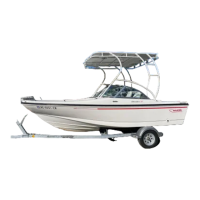
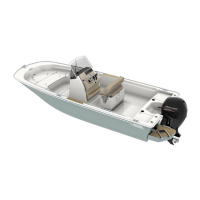
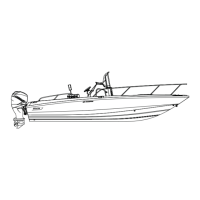
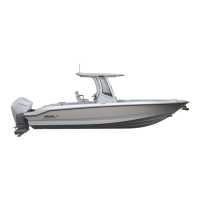
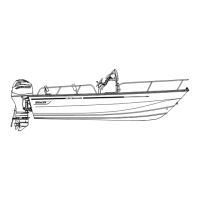
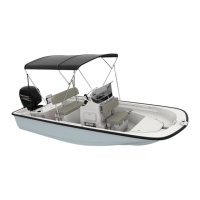


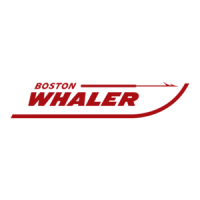

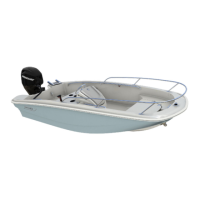
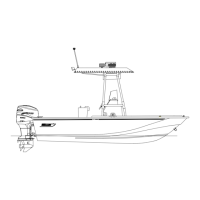
